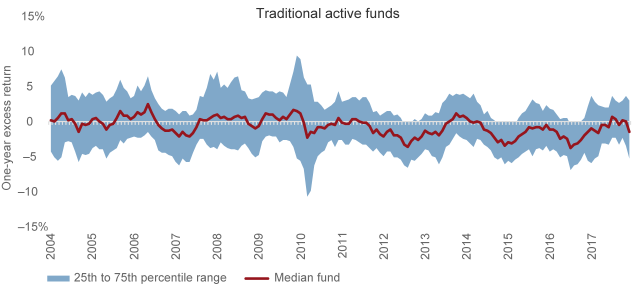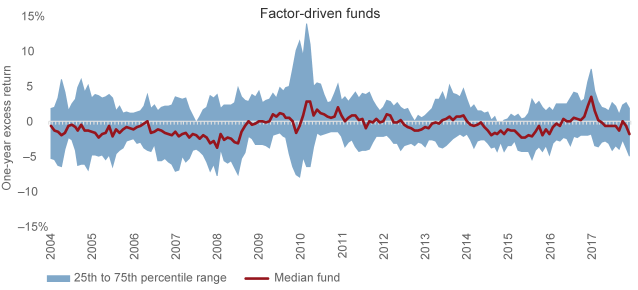Have you ever ridden a roller coaster in the dark? As you were getting situated, the attendant probably told you to fasten your seat belt and to hold on to the safety bar at all times. You felt confident you would feel good when the ride was over but knew some stomach-churning periods were along the way. Worse, since it was dark, you didn’t know when those tough moments would come, how long they would last, or how dramatic they would be. Your job was just to not panic and hold on.
Q3 hedge fund letters, conference, scoops etc
Rules-based ≠ lower risk
Roller coasters usually come with padded steel bars that lock and protect the rider. But be aware that factor funds, just like traditional active funds, do not come with similar safety features. A common misconception is that equity factor-driven funds are universally more “conservative” than traditional active funds when it comes to performance variability relative to broad market-cap-weighted indexes over short periods of time. That’s because many equity factor-driven funds are transparent, rules-based, and track an index. What is often overlooked is that a lot of feed into the design of different indexes and active factor strategies that can drive materially different performance. Assessing these differences will help shed light on how big or small the roller-coaster ride may be for your clients.1 After all, they will want to know ahead of time if the roller coaster you’re strapping them into could come with loops, corkscrews, or pretzels. The charts below demonstrate that relative performance variability of U.S. equity factor-driven funds can be just as large as that of traditional active.
Relative performance of equity factor-driven funds can be similar to that of traditional active
Source: Vanguard calculations, based on data from Morningstar, Inc.
Notes: The returns for factor-driven funds are based on conventional and exchange-traded equity funds from the strategic beta category of the Morningstar database. For a definition of what funds Morningstar classifies as strategic beta, please see: https://corporate.morningstar.com/US/documents/Indexes/Strategic-Beta-FAQ.pdf. We excluded sector, thematic, leveraged, and micro-cap funds to focus the comparison on more diversified fund options. Funds were assigned a proxy benchmark based on the Morningstar investment-focused market-capitalization designation. The proxy benchmark for large-cap-focused funds was the MSCI US Large Cap 300 Index through January 30, 2013, and the CRSP US Large Cap Index thereafter; for mid-cap-focused funds, we used the MSCI US Mid Cap 450 Index through January 30, 2013, and the CRSP US Mid Cap Index thereafter; and for small-cap-focused funds, we used the MSCI US Small Cap 1750 Index through January 30, 2013, and the CRSP US Small Cap Index thereafter.
Be ready for a bumpy ride
Although traditional active funds have tended, on average, to exhibit slightly wider differences from market-capitalization indexes, many traditional active funds have demonstrated lower relative performance cyclicality than certain factor-driven funds. Therefore, the reality is, the roller-coaster ups and downs for some equity factor funds can be as large as or larger than some traditional active strategies.
When it comes to putting clients’ assets in equity factor funds, a critical task is for you to act like the ride attendant with the measuring stick. Some clients need a ride appropriate for their risk tolerance. Others may simply need their expectations properly set in advance. along the way (as funds out- and underperform the broad market), all while making them feel confident that the long-term outcome will be worth the ride.2
Be sure to assess what performance cyclicality is reasonable to expect for the equity factor funds you are considering for clients. Factor funds are not a more conservative form of traditional active funds; indeed, their variability of performance may look similar. Therefore, you may need to prepare your clients for something much more important than a roller coaster in the dark.
Rread The full article here by Doug Grim of Vanguard, Advisor Perspectives


